In This Article
This post may contain affiliate links, please see our privacy policy for details.
Get ready to dive deep into the mesmerizing world of French Press coffee in this all-inclusive guide. If you've ever dreamed of recreating that perfect café-quality cup in the comfort of your own home, then buckle up, because you're about to embark on an exciting journey of brewing discovery. We'll untangle the process, illuminate the subtleties, and arm you with the know-how to rival any barista.
First stop on our coffee journey? Understanding the essence of French Press coffee. This brewing style plunges coffee grounds into hot water for full immersion, leading to a brew that's rich, aromatic, and bursting with flavor. Simplicity meets sophistication in this method, adored by coffee aficionados for the pure, bold tastes it unlocks.
However, the allure of the French Press doesn't halt at the traditional hot brew. This adaptable brewing buddy also whips up delightful iced coffee and silky, potent cold brew. The French Press is like a passport to a world of diverse coffee delights. From steaming hot to refreshingly cool, and every temperature in between, we've got your cravings catered for. So let's set off together on this French Press coffee adventure.
CONTENT SUMMARY
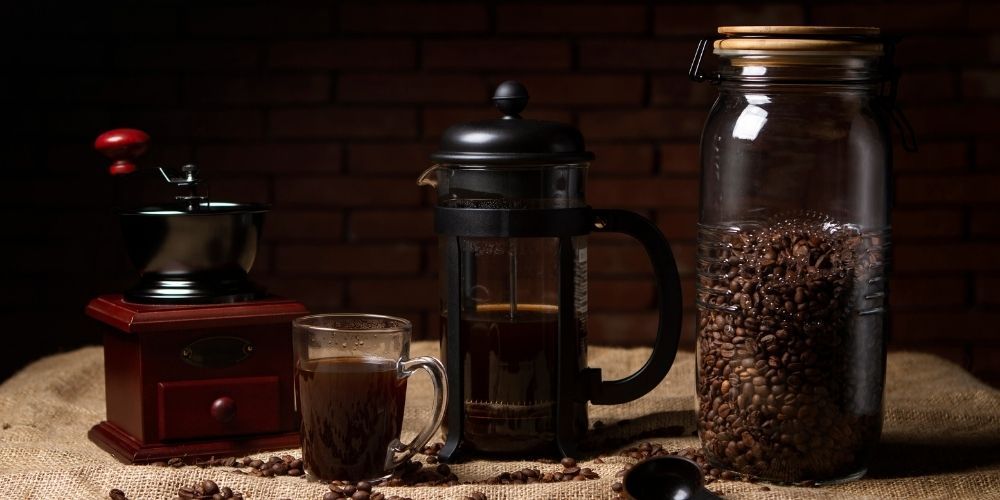
Understanding the French Press
Components of a French Press Coffee Maker
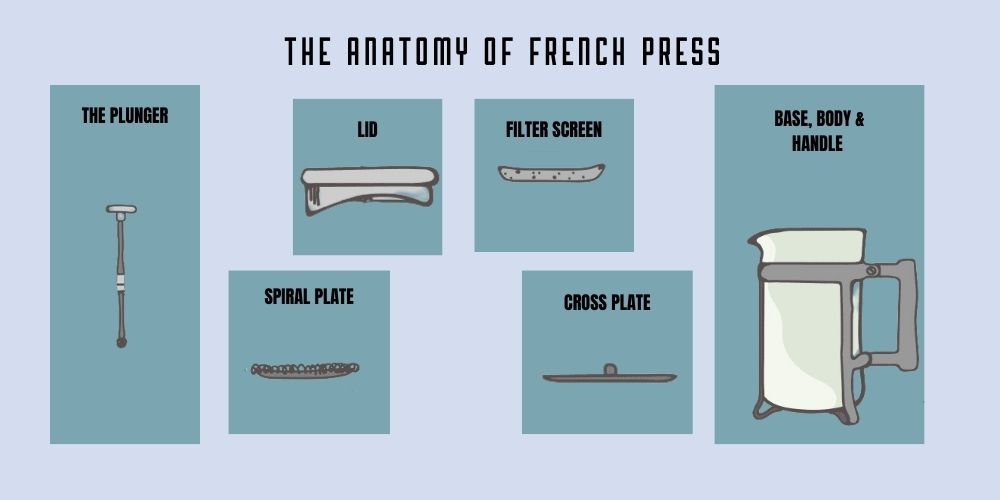
When you look at a French Press coffee maker, you'll find it's a pretty simple yet ingeniously designed piece of equipment. At its heart, you'll see a cylindrical beaker. This is traditionally made of clear, heat-resistant glass, but you might also find variations crafted from sturdy stainless steel or practical plastic.
Popping out from the top of the beaker is the lid, which can be made of metal or plastic. This isn't just any lid, though. Attached to it is a crucial part of the French Press magic: the plunger. This key component houses a fine mesh filter at its base designed to masterfully separate your coffee grounds from the finished brew.
Sure, you might stumble across models sporting additional bells and whistles. But at its core, these are the elements that make a French Press, well, a French Press! It's a marvel of simplicity, a testament to the fact that the best ideas often come without frills and complications.
Discover more coffee bliss with our enticing Coffee Series: Coffee Maker with Grinder, Iced Coffee Makers, Small Coffee Makers, Coffee & Espresso Maker Combos & Manual Coffee Makers
Why Use a French Press: The Benefits and Unique Characteristics
The French Press offers several benefits that set it apart from other coffee brewing methods. Here are some reasons why you might want to consider using a French Press:
- Full-bodied flavor: The French Press allows the coffee grounds to steep directly in hot water, which results in a more robust flavor extraction compared to other brewing methods. The metal filter allows the natural oils from the coffee beans and fine particles to flow into the brew, adding to its body and taste.
- Control: With a French Press, you have complete control over the brewing process — the coffee-to-water ratio, water temperature, and steeping time. This allows you to adjust the taste to your preference.
- Simplicity and Convenience: The French Press is easy to use and requires no electricity, making it portable and perfect for travel, camping, or office use.
- Versatility: Beyond brewing hot coffee, a French Press can also be used to make cold brew, iced coffee, and even loose leaf tea.
- Sustainability: With no need for paper filters or plastic pods, the French Press is a more environmentally friendly option.
Choosing the Right Ingredients

When it comes to choosing the right ingredients for a French Press, there are a few key factors to consider: the type of coffee beans, their origin, and the roast type. Additionally, determining the appropriate coffee-to-water ratio is crucial for achieving the desired strength and flavor in your French Press brew. Let's explore each of these aspects in detail:
- Coffee Beans: The best coffee beans for French Press brewing are those that have a bold and robust flavor profile. Generally, medium to dark roasted beans work well as they retain their flavors even after the immersion brewing process of the French Press. Look for beans with tasting notes of chocolate, caramel, nuts, or even fruity undertones. Consider exploring single-origin beans or blends based on your personal preferences.
- Origin: Coffee beans come from various regions worldwide, and each region imparts unique flavors to the beans. The origin of the beans is a matter of personal preference, but some popular regions known for producing quality beans include Colombia, Brazil, Ethiopia, Guatemala, and Sumatra. Experimenting with different origins can help you discover the flavor profiles that you enjoy the most.
- Roast Type: The roast level affects the flavor and intensity of the coffee. For French Press brewing, medium to dark roasts are generally preferred due to their richer and bolder flavors. Lighter roasts may result in a more acidic and delicate brew, which might not be as suitable for the immersion method of the French Press.
Now, let's move on to the coffee-to-water ratio:
The general guideline for the coffee-to-water ratio in a French Press is 1:15 or 1:16. This means using 1 gram of coffee for every 15-16 grams of water. However, the ratio can be adjusted based on personal preference and desired strength. You can experiment with different ratios to find the one that suits your taste.
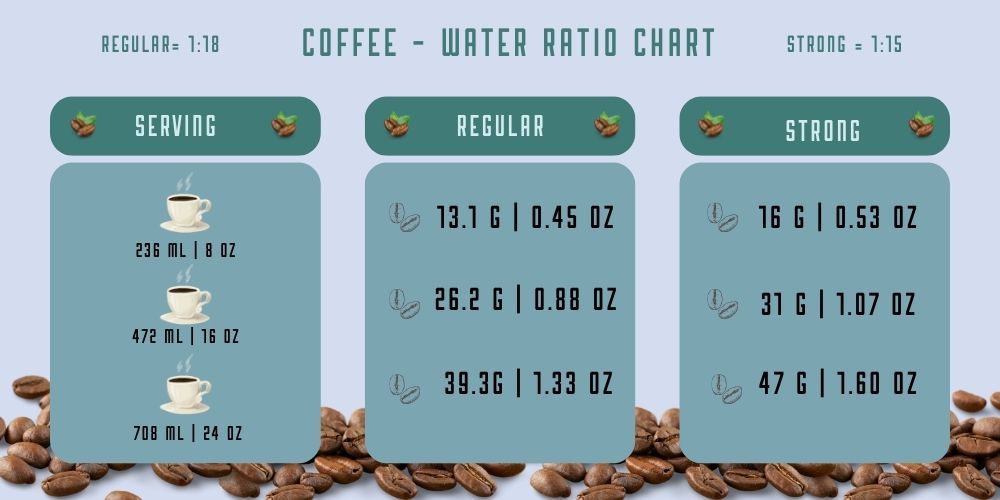
Factors that can influence the ratio include:
Strength Preference
If you prefer a stronger brew, you can increase the coffee-to-water ratio. For example, using 1 gram of coffee for every 14 grams of water will result in a stronger cup. On the other hand, if you prefer a milder brew, you can decrease the ratio slightly.
Coffee Beans and Roast
Different coffee beans and roast levels can impact the extraction process. Darker roasts may require a slightly higher ratio, while lighter roasts may work better with a slightly lower ratio. Adjust the ratio accordingly to achieve the desired flavor extraction.
Brew Time
The duration you let your French Press brew can also influence the strength and flavor. If you prefer a stronger cup, you can increase the brew time slightly. Conversely, a shorter brew time can result in a milder cup.
Remember that these ratios and adjustments serve as general guidelines and personal taste preferences may vary. It's always a good idea to experiment and adjust the variables to achieve the perfect cup of coffee with your French Press.
Venture into the realm of alternative brews with our curated selections of Mushroom Coffee, Low Acid Coffee, Green Coffee & Espresso Coffee
The Importance of Coffee Grind
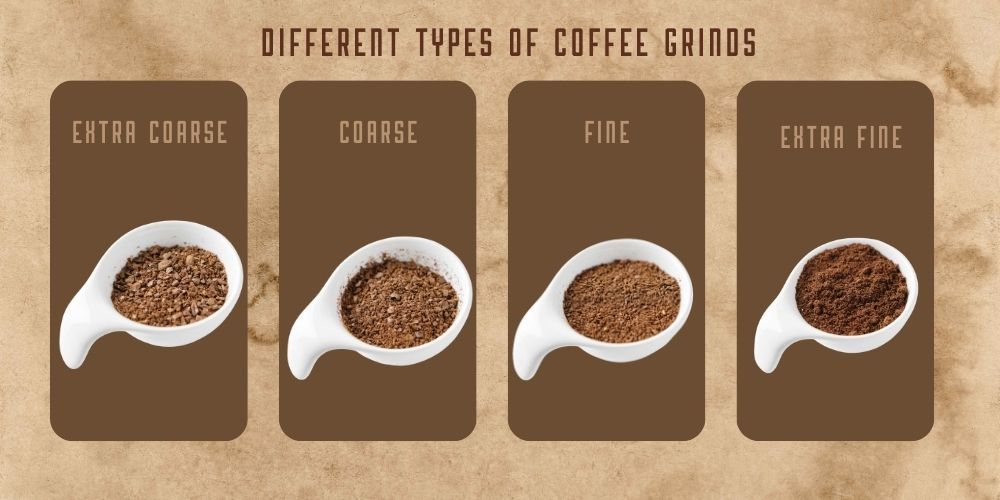
Coffee grind size plays a crucial role in the flavor extraction process, especially when brewing coffee with a French Press. Understanding the appropriate grind size for French Press and its impact on flavor extraction is essential for achieving a balanced and flavorful cup of coffee.
In the case of French Press brewing, a coarse grind size is recommended. Here's why grind size matters:
Flavor Extraction
The grind size affects the surface area of the coffee particles exposed to water during brewing. In a French Press, the coffee grounds are steeped in water for an extended period, and a coarse grind allows for a slower extraction process. This slower extraction helps prevent over-extraction and bitterness while allowing the flavors and oils to be extracted more evenly.
Body and Mouthfeel
The grind size also influences the body and mouthfeel of the coffee. A coarser grind in a French Press allows for more particulate matter to pass through the metal mesh filter, resulting in a fuller-bodied and slightly thicker cup of coffee. This can contribute to a more satisfying and robust drinking experience.
Sediment Control
French Press brewing often results in some sediment or "sludge" in the cup due to the metal mesh filter. Using a coarse grind can help minimize the amount of fine particles that make their way into the brewed coffee, reducing the sediment and providing a cleaner cup.
Now, let's discuss the best coffee grinder for French Press and what to look for:
For French Press brewing, a burr grinder is generally recommended over a blade grinder. Burr grinders provide a more consistent grind size, which is crucial for ensuring an even extraction. Blade grinders, on the other hand, tend to produce an uneven grind, resulting in inconsistent flavor extraction.
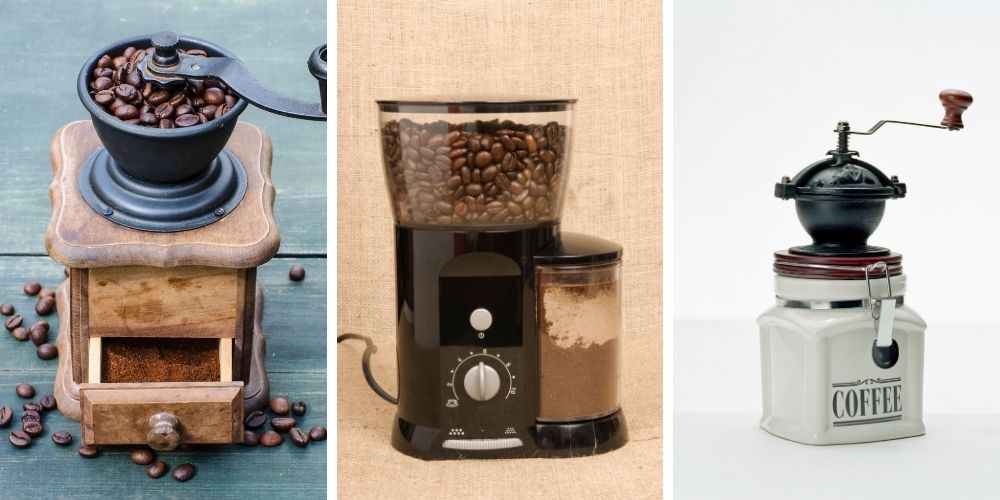
When choosing a burr grinder, consider the following factors:
- Burr Type: Look for a grinder with conical or flat burrs. These burr types are known for their consistent grind size and are suitable for French Press brewing.
- Grind Size Adjustability: Ensure that the grinder allows you to adjust the grind size to achieve the desired coarseness. This flexibility is important as it allows you to fine-tune the grind size based on your personal preferences and the characteristics of the coffee beans.
- Build Quality and Durability: Consider the build quality and durability of the grinder. Look for grinders made from sturdy materials that can withstand frequent use. Stainless steel or ceramic burrs are often preferred for their durability.
- Capacity and Convenience: Evaluate the grinder's capacity and ease of use. Consider whether the grinder can handle the desired quantity of coffee beans you plan to grind and if it offers convenient features such as a removable hopper or easy cleaning options.
Some popular burr grinders for French Press brewing include brands like Baratza, Breville, and Rancilio. However, it's worth exploring different options and reading reviews to find the grinder that best fits your budget and requirements.
Investing in a quality burr grinder will enhance your French Press coffee brewing experience by allowing you to consistently achieve the optimal grind size for maximum flavor extraction.
Step by Step: Making Coffee with a French Press
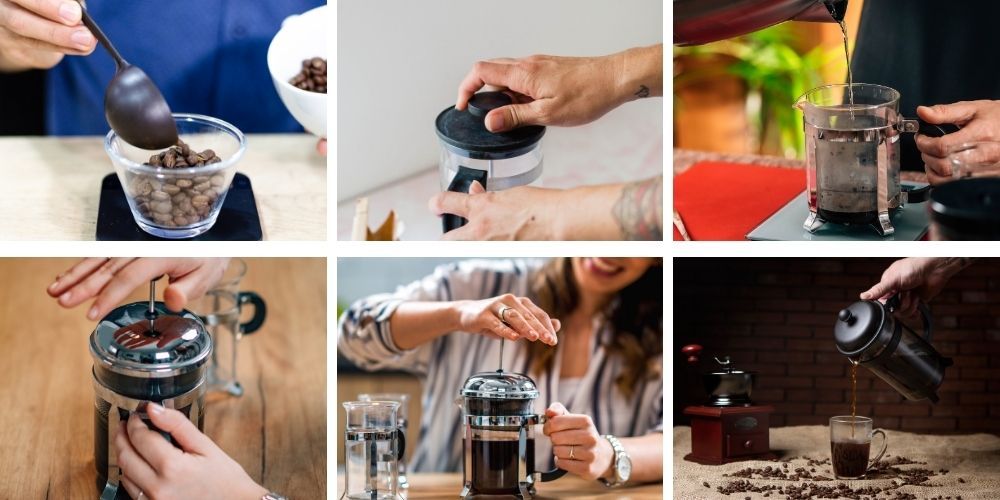
Step 1: Gather Your Equipment:
- French Press coffee maker
- Freshly roasted coffee beans
- Coffee grinder
- Kettle or pot for boiling water
- Stirring utensil (preferably wooden or plastic)
- Timer (optional)
Step 2: Measure and Grind the Coffee:
- Start by measuring the desired amount of coffee beans. As a general guideline, use a ratio of 1:15 to 1:16 (coffee to water) for a balanced cup of coffee. Adjust the ratio based on your preference.
- Grind the coffee beans using a burr grinder to achieve a coarse grind size suitable for French Press brewing.
Step 3: Preheat the French Press:
- Pour hot water into the French Press to preheat it. Swirl the hot water around the beaker for a few seconds, then discard the water.
Step 4: Add Coffee and Water:
- Add the freshly ground coffee into the preheated French Press. Use the appropriate amount based on your desired coffee-to-water ratio.
- Start pouring hot water into the French Press, ensuring that it covers all the coffee grounds. Pour slowly and in a circular motion to saturate the grounds evenly. Leave a small gap at the top to prevent overflow during the brewing process.
Step 5: Stir and Steep:
- Use a wooden or plastic stirring utensil to gently stir the coffee and water mixture, ensuring all the grounds are fully immersed.
- Place the plunger and lid on the French Press but do not press it down yet.
- Let the coffee steep for about 4 to 5 minutes. Adjust the steeping time based on your preference and the desired strength of the coffee. For a stronger brew, you can extend the steeping time slightly.
Step 6: Plunge and Pour:
- After the desired steeping time, slowly press the plunger down, applying even pressure. The mesh filter will separate the coffee grounds from the liquid as you press down.
- Once the plunger is fully pressed down, start pouring the brewed coffee into your cups or mugs immediately to prevent over-extraction.
Step 7: Enjoy and Adjust:
- Serve the freshly brewed coffee and enjoy the rich flavors of your French Press brew.
- Taste the coffee and take note of its strength and flavor. If it's too strong or weak, you can adjust the coffee-to-water ratio, grind size, or steeping time accordingly in your next brew to achieve your desired taste.
Remember to clean your French Press thoroughly after each use to maintain its performance and longevity. With practice and experimentation, you can fine-tune the measurements and adjustments to make the perfect cup of coffee with your French Press.
How to Make Iced Coffee with French Press
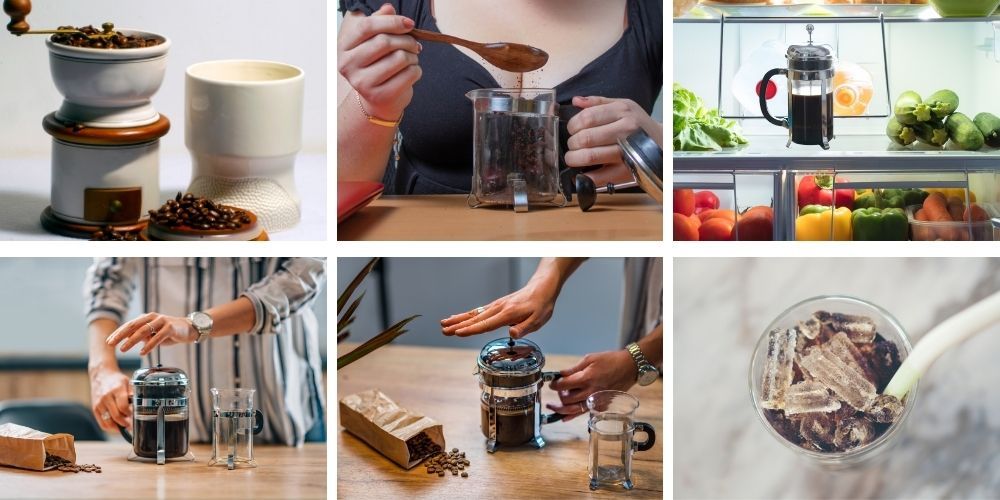
Making French press iced coffee is a straightforward process that yields a refreshing and flavorful cold coffee. The main differences from making hot coffee in a French press lie in the proportions and brewing time. Here are step-by-step instructions to guide you:
Ingredients and Equipment:
- Coarsely ground coffee beans
- Cold, filtered water
- French press
- Ice cubes
- Optional: milk, sweetener, or flavorings of your choice
Step 1: Measure and Grind Your Coffee (See Step 2 of Making Coffee with a French Press)
A stronger brew is typically desired for iced coffee, so adjust your coffee-to-water ratio to 1:7. This considers the dilution effect of the melting ice in the final serving.
Step 2: Add Coffee and Cold Water (Refer to Step 4 of Making Coffee with a French Press)
Add your coarsely ground coffee to the French Press, and then pour in cold, filtered water. Stir the mixture gently to ensure all coffee grounds are fully immersed.
Step 3: Steep
Instead of the usual hot brew steep time, let your coffee steep in the refrigerator for 12-15 hours. This long, cold steeping process results in a rich and smooth iced coffee.
Step 4: Plunge, Pour Over Ice, and Serve (Refer to Step 6 of Making Coffee with a French Press)
After the extended steeping time, press the plunger down slowly to separate the coffee grounds from your iced coffee. Pour the coffee over a glass full of ice. If desired, you can add milk, sweetener, or other flavorings.
And voila! A refreshing cold brewed coffee awaits you. The beauty of this process is that it allows you to highlight the nuanced flavors of your coffee, resulting in a less acidic and smoother brew. Enjoy the flexibility and creativity of this method as you experiment with different beans, steep times, and additives to create your perfect iced coffee.
Discover iced coffee bliss with our enticing Iced Coffee Series: What is Iced Coffee, How to Make Iced Coffee, Iced Coffee Makers, Protein Iced Coffee Recipes
How to Make Cold Brew Coffee with a French Press
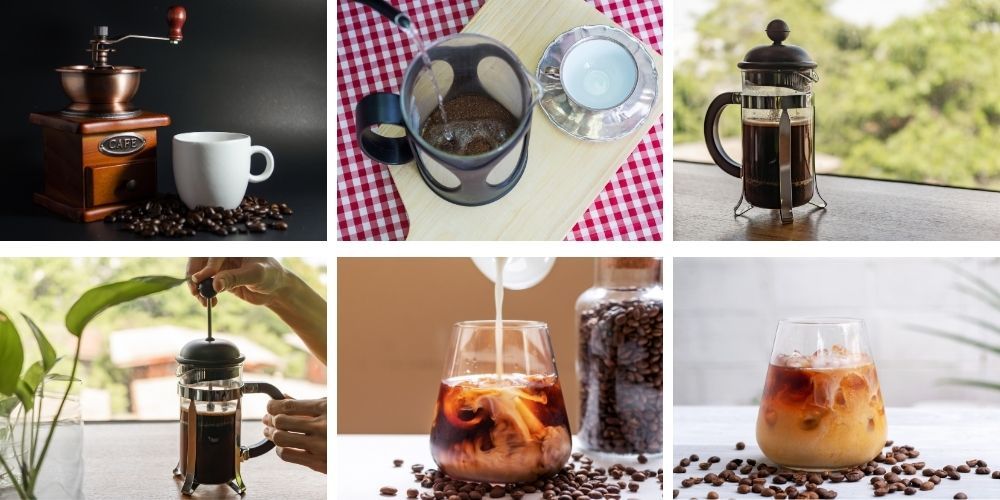
Cold brew coffee concentrate in brewing coffee that uses cold or room temperature water over an extended period of time, resulting in a smooth, low-acidity coffee concentrate. Unlike traditional hot coffee brewing methods, cold brew extracts the flavors from the coffee beans slowly and produces a less acidic and less bitter beverage. The use of a French press for cold brew is convenient and effective in achieving a rich and flavorful concentrate. Here's a step-by-step guide to making cold brew coffee with a French press:
Ingredients and Equipment:
- Coarsely ground coffee beans
- Cold, filtered water
- French press
- Optional: milk, sweetener, or flavorings of your choice
Step 1: Measure and Grind Your Coffee (Refer to Step 2 of Making Coffee with a French Press)
For cold brew, you'll generally need a ratio of 1:7 or 1:8 (coffee to water). Adjust the quantity based on your preference and the size of your French Press.
Step 2: Add Coffee and Water (Refer to Step 4 of Making Coffee with a French Press)
Remove the plunger and add the coarsely ground coffee to your French Press. Next, pour in cold, filtered water. Stir the mixture gently to ensure all coffee grounds are fully immersed.
Step 3: Steep
Position the plunger on top of the French Press but do not press it down. Allow the coffee to steep at room temperature for 12-24 hours. This long steeping time extracts the flavors slowly, producing a less acidic and less bitter coffee concentrate.
Step 4: Plunge and Decant (Refer to Step 6 of Making Coffee with a French Press)
After the steeping time, press the plunger down slowly, being careful not to agitate the coffee grounds. Decant the brewed coffee into a separate container.
Step 5: Dilute and Serve
Dilute your cold brew concentrate with cold water or milk to taste. A typical ratio is 1 part coffee concentrate to 2-3 parts water or milk, but this is subjective. Pour the diluted cold brew over ice and enjoy!
And that's it! You now know how to make a delectable cold brew using your French Press. This method will allow you to appreciate the unique flavors of your coffee, resulting in a smooth, less acidic brew. Have fun experimenting with different beans, steep times, and dilution levels to craft your perfect cup of cold brew coffee. Remember, any leftover concentrate can be stored in the refrigerator for up to a week and is a great option for making iced coffee, as it retains its rich flavor even when mixed with ice.
Discover more cold brew coffee picks with our enticing Cold Brew Series: What Is Cold Brew Coffee, Cold Brew Coffee Makers, Manual Coffee Makers
Tips for Perfect French Press Coffee
To make the perfect French press coffee, here are some tips to follow:
Proper cleaning and maintenance of the French Press
Regularly clean your French press to remove any coffee residue. Disassemble the components and wash them with warm, soapy water. Rinse thoroughly to ensure no soap residue remains. This helps maintain the taste and quality of your coffee.
Use coarsely ground coffee
Opt for a coarse grind when using a French press. Finely ground coffee can result in over-extraction and a bitter taste. The coarser grind allows for better water flow and extraction.
Get the coffee-to-water ratio right
Experiment with the coffee-to-water ratio to find the perfect balance for your taste. A general guideline is to use a ratio of 1:15, which means 1 part coffee to 15 parts water. Adjust this ratio according to your preference.
Steep time and water temperature
The ideal steep time for French press coffee is around 4-5 minutes. Steeping for too long can result in a bitter taste. Additionally, ensure that the water temperature is around 195-205°F (90-96°C) for optimal extraction.
Avoid common mistakes
Avoid pressing the plunger too forcefully as it can lead to fine coffee particles passing through the filter and resulting in a gritty texture. Also, be cautious while pouring to avoid spills or splashing.
Experiment with steep time and ratio
To personalize the flavor of your French press coffee, experiment with different steep times and coffee-to-water ratios. You can adjust these variables to find your preferred strength and flavor profile.
By following these tips, you'll be on your way to brewing the perfect cup of French press coffee that suits your taste preferences.
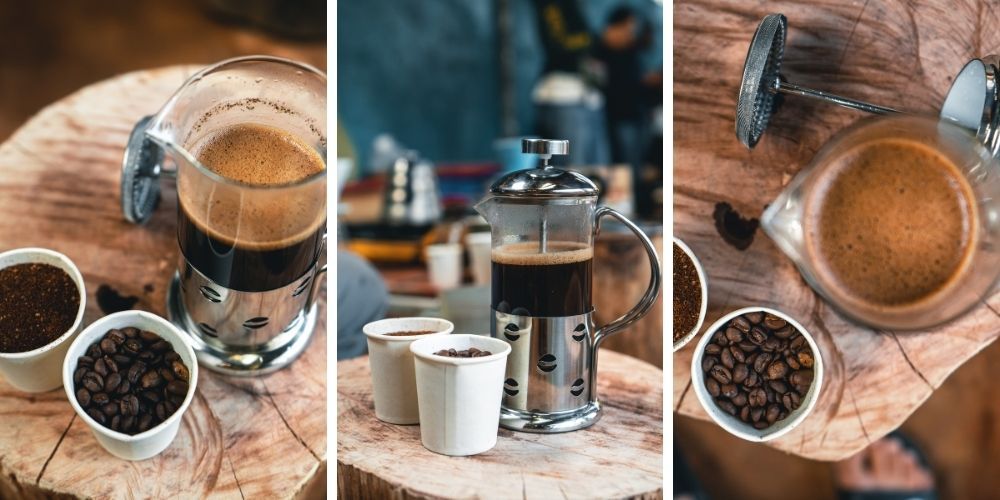
Immerse yourself in the invigorating world of espresso coffee with our specially curated selections. Unleash your inner barista with our guide on How to Make an Espresso, Coffee & Espresso Maker Combos, Espresso Coffee
Final Thoughts
Mastering the art of using a French press can enhance your coffee experience significantly. Through proper maintenance, avoiding errors, and experimenting with variables like coffee-to-water ratio and steep time, you can unleash the full potential of this brewing method. With practice and a willingness to explore different techniques, you'll be able to create an intense cold brew concentrate or enjoy a hot brewed coffee using just a French press. You can also use a French press to make an iced vanilla latte, Vietnamese iced coffee, and refreshing iced coffee. So, grab your French press, and quality coffee beans, and embark on a journey of flavor and aroma as you savor each sip of your meticulously crafted coffee creations. Happy brewing!










